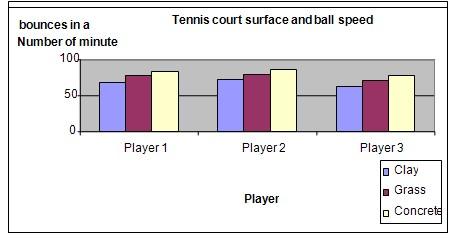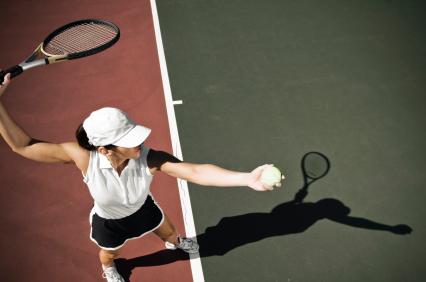| Complexity level: | 6 |
| Project cost ($): | 70 |
| Time required: | 1 hour to prepare, 1 day for the science project experiment |
| Material availability: | Easily found |
| Safety concerns: | Basic safety requirements |
Hypothesis
A tennis ball will bounce fastest on a asphalt tennis court surface.
Overview
Tennis court surfaces
A tennis court is the place where tennis games are played. It consists of a rectangular flat surface that is made of either clay, grass or asphalt. Besides these, artificial turf, as well as rubberized surfaces are used for indoor courts. A low net is strung in the middle of the court dividing it into two. Depending on the athlete’s style of playing, the type of court surface played on can influence the game and give one player an advantage over another.
A clay court is made out of crushed stone, shale or brick. It is normally built on a concrete foundation and will have a smooth surface. Tennis ball speeds are normally reduced when they bounce on a clay surface. Long rallies are normally played on clay courts and this gives an advantage to players whose strength is in playing at the baseline.
Playing on a grass court will require fast play. This is because the uneven grass surface will make the ball bounce fast, low and unpredictably. Players whose strengths are in their serve and volleying tend to perform better on a grass court due to erratic and unpredictable ball movement as the ball bounces of the grass surface.Baseline players will be at a disadvantage.
The asphalt court is the most common type of tennis court. The firm, flat and even surface makes it easier to predict the movement of the ball when it bounces off the hard surface. This court is regarded as the most "neutral" court, and most players are able to play well on this type of court (compared to the other types), regardless of their strengths. The US Open is played on hard courts.
Materials
The materials required for this science fair project:
- 3 experienced tennis players (preferably those who play competitive tennis)
- 3 tennis balls (new balls required - ensure that all 3 are from the same box)
- 3 tennis racquets (identical string tension - try asking the players to lend you their racquets, and have them restrung to the same tension level)
- A stopwatch
- An assistant to help with the measurements
- A clay tennis court
- A grass tennis court
- An asphalt tennis court
Procedure
1. For this science fair project, the independent variable is the type of tennis court used – clay, grass or asphalt. The dependent variable is the speed of the ball bouncing off the court surface. This is determined by counting the number of times the ball bounces off the surface within a certain period of time. The amount of time the ball is allowed to bounce is measured with a stop watch. The constants (control variables) are the racquet string tension, the tennis ball pressure and the tennis player’s experience/abilities.
2. The locations of 3 tennis courts, each made of clay, grass and asphalt surfaces are determined.
3. The 3 tennis players are first brought to the clay court. Test the players one at a time. Using the tennis racquet, each tennis player will bounce the tennis ball up and down against the court surface . This will be done continuously for 1 minute. The stopwatch is started and the number of times the ball bounces off the court surface is counted. The procedure is repeated 5 times per player on each type of court surface and the greatest number of bounces is recorded in the table given below.
4. Procedure 3 is repeated on the grass and asphalt tennis court surfaces and the greatest number of bounces made by the tennis ball by each player after 5 attempts is recorded in the table given below.

Results
It is observed that for all 3 players, the number of times the tennis ball bounced off the surface was the highest at the tennis court with the asphalt floor surface.
| Player | Court surface type and number of bounces in a minute | ||
| Clay | Grass | Asphalt | |
| Player 1 | 68 | 77 | 83 |
| Player 2 | 72 | 79 | 87 |
| Player 3 | 62 | 71 | 78 |
The graph below represents the results of our science experiment

Conclusion
The hypothesis that a tennis ball will bounce fastest on an asphalt tennis court surface is proven to be correct.
There are four major Grand Slam tennis tournaments each year. They are the US Open, Australian Open, French Open and Wimbledon. Only the French Open is held on a clay court surface. The US Open and the Australian Open are held on hard courts. The Wimbledon Open is held on a grass court. It takes great skill to be able to win all 4 grand slams (and players who win all 4 during their careers are said to have achieved Career Grand Slam). Few players have accomplished this in singles play, including Andre Agassi, Roger Federer, Rafael Nadal, MArtina Navratilova, Steffi Graf and Serena Williams)
Also consider
This science fair project might also be repeated using a a different kind of ball (eg. basketball) instead of a tennis ball.
Try to repeat the experiment in different weather conditions like on a hot afternoon, early morning or after a rainy day as weather conditions do affect how a court surface "performs",
References
Tennis court - http://en.wikipedia.org/wiki/Tennis_court
Tennis court surfaces – clay, concrete and grass - http://www.essortment.com/hobbies/tenniscourtsur_sxpa.htm

